Living in the Past: Meet the Knight Order of St Nicholas in Varaždin
November 20, 2019 - We are delighted to welcome Janja Šestak to TCN, the first of our three new interns from the Faculty of Political Science & Journalism in Zagreb. A really great first piece on the Knight Order of St Nicholas Varaždin. And you thought Gen Z was lost all day in gadgets...
A new departure in the random TCN journey of life, as we start our first internship programme. Am very grateful to Janja, Ana and Paula for agreeing to join this experiment. I first met Janja after I gave a lecture at the university. She told me that she wanted to apply for the internship, but was not sure what she could write about, and she was worried that her English would not be good enough. I told her to relax, we discussed what her interests were.
And then she produced this!
Excellent start, young lady - more of the same please...
xxxx
Have you ever dreamt about stepping a few steps back in history? Have you ever dreamt of what was like to live in a castle? Dancing around the field with the knight and ladies? Crazy, isn't it? And what if I tell you all of this is possible in the 21st century? Even crazier, right?
In the small, baroque city of Varaždin in northern Croatia, you can find real knights and real ladies from the Middle Ages. You must be wondering right now, how is this possible? Let me introduce you to the Knight Order of St Nicholas Varaždin. This reenactment group retells the stories from the past, covering the history of the 12th to the 15th century.
Croatia has its reenactment scene and plenty of groups that go back in time almost every weekend. Every weekend they appear in a different place depending on the story behind it. Today I will present you a group that is protecting the ramparts of Varaždin.
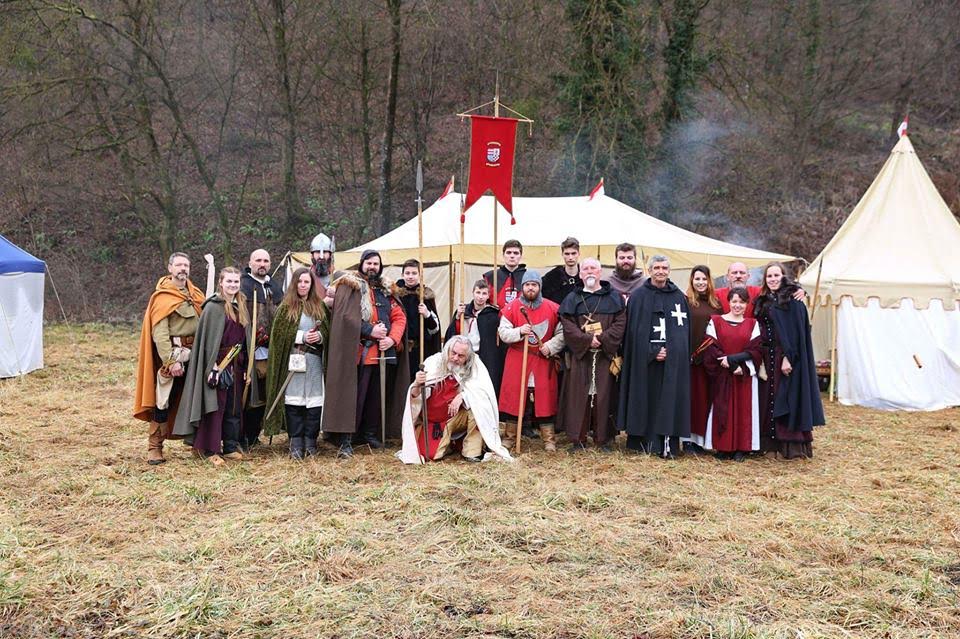
Escape the 21th century and come back with me to where the idea came from
The historical group was founded on 27 December 2011 by three archers, Radivoj Miladinović, Nenad Slukić, and Sanjin Rožić. They were in a sports club, but they wanted something different, something new. One of the first rules they agreed on was that the group would be unprofitable. "Money corrupts people", they said. They wanted to be in a relaxed, friendly circle of people.
After they studied the history of Varaždin in detail - customs, traditions, clothing, even material for clothing - they started with some real things. They sewed their clothes in the exact form as it was, they made a couple of tents, wooden chairs and tables, agreed on a hierarchy in the group, and started gathering people. The first people to join were family members and friends. As the group was spreading, it gathered people with different talents and abilities. Some of them knew how to sew clothes, some of them were making jewelry, one woman knew calligraphy, a few of them were making swords, axes, chain-mail, shields, even authentic boots! If you notice, every person has some task in this group and it is something they are good at. When they go on tournaments, you know exactly who is in charge of what. And because of that, it's much easier to maintain a group.
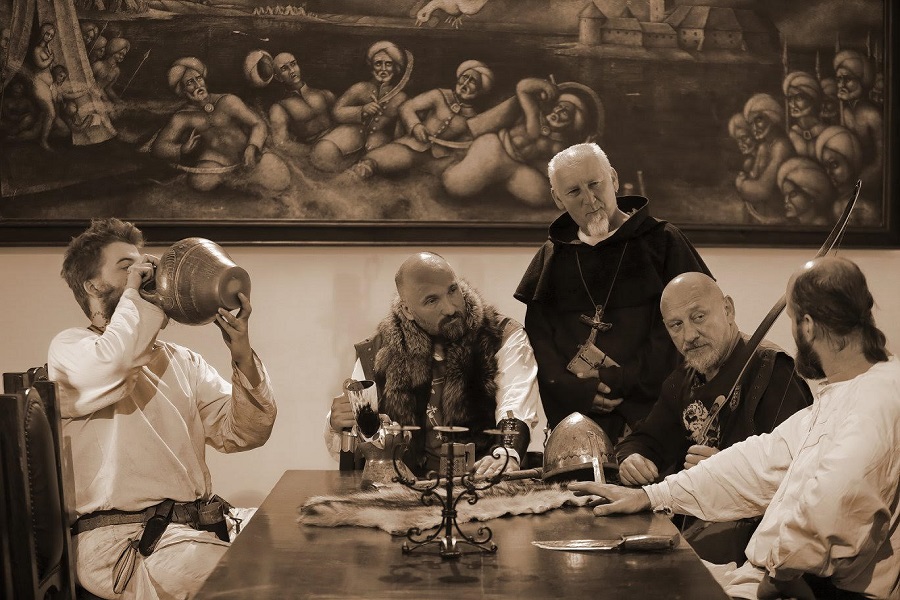
How do they dress?
Given that such clothing cannot be bought anywhere, they started making their clothes. They have learned from historical sources what material it should be, what patterns, how many layers of clothing, how citizens dressed, and how the nobility dressed. The women wore an underdress (smock) and houpelande, made of flax or raw cotton cloth. Depending on their stock, that is, their position in society, they enriched their clothes with various fur ornaments, the jewelry they made and belts around their waists. They would have a leather pouch called a gipser, which carryied the most essential items on their belt, just like men. Take the example of an ordinary citizen. His clothing consisted of pants made of flax or raw cotton cloth, with wool hose and leather shoes over them. The upper part of the body would be covered by a kirtle also made of the materials already mentioned, and a long tunic of wool or other warmer material would be put over it. During evening gatherings or cold nights, mantles were used, not with hoods as we see it in the movies, but those that looked more like a poncho. These are called paltocks. The hood was worn separately and was designed to cover the shoulders and part of the chest. It was made of wool because in previous times winter and evening were colder than they are now. Both men and women wore lightweight headgear throughout the day. A noble's clothes differed by being more luxurious, with gold buttons, with more fur, more elegant, better quality. Flax was mainly used for underwear, pants, while the outer layers were made of wool. All members of the group adhere to these rules because what they are constantly striving for is authenticity.
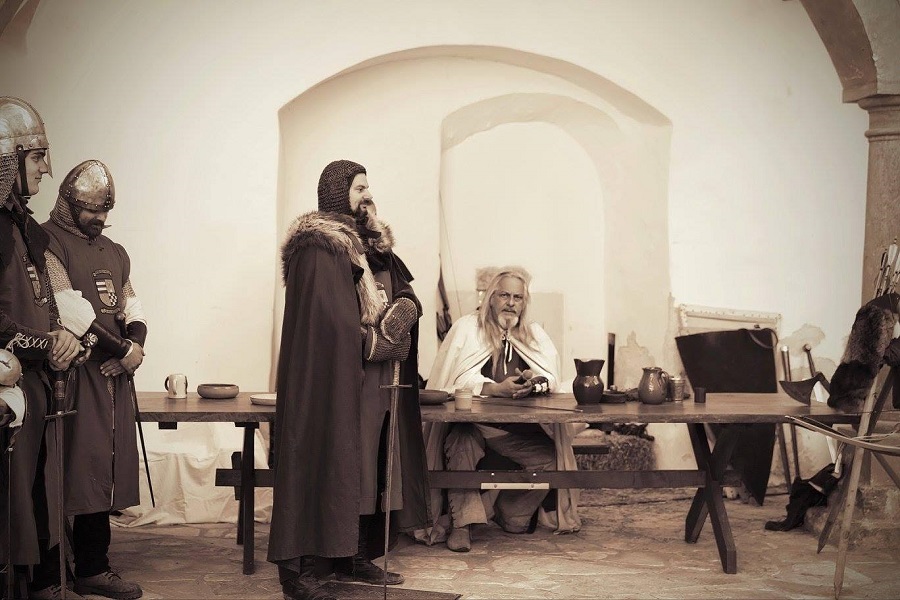
And what do they need to look like authentic warriors?
Each member of the association has a specific role in the Order and therefore owns certain equipment. Members who choose to be warriors with swords own a sword, a shield, a helmet, chain-mail that has tens of thousands of connected small iron rings, armour, shoulder protectors, arms, elbows, knees, shins. Likewise, every warrior owns a gambeson, a piece of equipment that resembles a modern coat, stuffed with multiple layers of fabric for colder days, and also to ensure that the metal armour does not go on the tunic alone. The gambeson, in addition to the coat, includes pants and a hat that goes under the helmet to prevent the helmet from damaging the head and to dampen any impact.
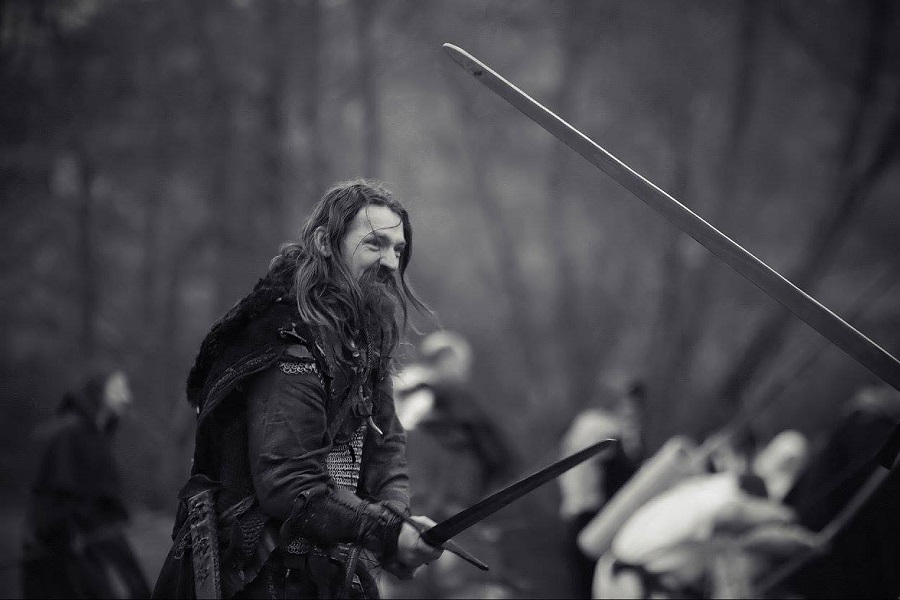
Depending on preferences, a member of the association chooses the weapon he or she wants; sword, ax, mace, knife, spear... Of course, all weapons are legally blunted and no injuries can occur. Archery warriors have their bow, arrows, bow, arm and finger protectors. They also wear helmets and headbands for protection. Archers were more readily equipped than knights who had full armour on them. The full armour worn by the knights weighs at least twenty pounds. For this reason, it is very difficult to move, fight or run. It is especially tiring when in such metal armour they have to stand in the sun or fight in the sun. But they do it all of their own free will, and they do not mind because they are already used to it.
You can check them out above on Lake Bled where they represented a military tactic called shield wall and archery training.
You might be wondering how their camp looks like
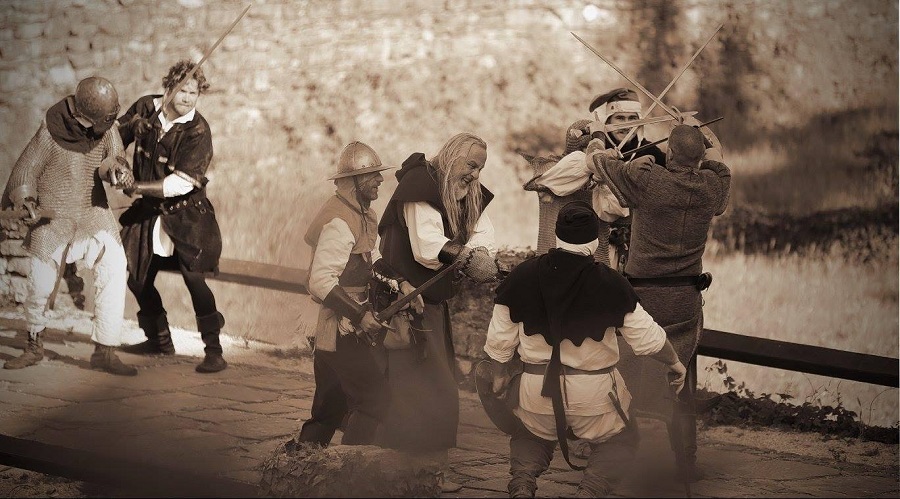
Furthermore, each knight's association has its camp, which usually consists of an awning and two tents. This is the case with this Order, where one tent serves them as a kitchen. It contains all the food, drinks, a table where food is prepared, a wooden shelf containing plates and glasses, and a trash bag. The awning is only covered, but if the members sleep under the awning at night, "walls" can be added for a warmer and more comfortable atmosphere. By day, all members are under the awning, there are tables, benches, under the awning is lunch, etc. The third tent is for personal belongings; all the bags, the sleeping bags, everything that belongs to the modern world. Each knightly association makes sure that there is nothing modern on the tables or in a visible place. Many photographers and cameramen go through the camps, so, looking at what is in the camp, they prove their authenticity. The plates are wooden, the glasses are ceramic and wooden, the accessories are wooden or metal. In the evening, they set up torches in front of the camp, which they also made themselves, which creates the perfect atmosphere.
Who is in charge and how to become a knight?
At the head of the Knight Order of St. Nicholas Varaždin is the President, Grand Master Luka Borščak, Vice-President Alen Posavec, and Secretary Ivana Kovaček. The members of the Presidency are elected for a term of two years and re-election is possible. The Supervisory Board consists of Aleksandar Farkaš, Vlatko Lazić, and Ratko Ćosić. As the principal of the association, they arrange tournaments, the programme to be run, find transportation, take care of all the documentation, and generally the operation of the group.
When a person just joins the Order, they are first introduced to the rules, hierarchy, plans, actions. First, an application is signed on which to write their personal information, talents, or abilities and what he/she would like to be in that Order. After that, the search for clothing and sewing materials begins, aided by members of the Order who know more about it. When a person obtains appropriate clothing and footwear, he or she can participate in events. For the first year, he has the status of a squire. At the first meeting, the person is assigned his mentor, and the new person is his squire. This means that the mentor instructs the squire in the world of chivalry, the knight's code, the work of the association, gives advice, and the squire assists the mentor in dressing military equipment, for example. For the first year, the squire is observing. The Order looks at his will, whether he has progressed in something in that year, looks at his behavior in the Order, whether he helps when the camp is building, or whether he helps other members. It is not some kind of surveillance, it simply pays a little more attention to the squire to decide after a year whether they are admitted to the Order or not.
If they prove to be worthy of joining the Order, men can claim the title of knight. The authorisation process can be done, at the request of the candidate, at an event or in a circle of association members. Most of them choose to be knighted at an event because it is a great honor and the audience has a rare opportunity to see the ceremonial process of authorisation. The ceremony is led by the Grand Master of the association, with the squire first standing in front of him, then kneeling on one knee. The Grand Master asks the candidate some of the following questions: Did you do a good deed? Did you save a lady in distress? Did you save your master? Did you learn archery, fencing and horse riding skills? Did you protect the weaker than yourself? Are you ready to defend women, the powerless and the master? Did you learn court dances? Are you ready at any moment, at the urging of your master, to defend your region, your people and your country?
This is followed by the sentence: “Now you will receive the last slap in your life that you cannot answer. Get ready.” After that comes the slap. Then the Grand Master pulls out his sword and says, "Get up Nicholas, Knight from the Raven's Mount."
Women, unfortunately, cannot become a knight because this is not historically accurate. Although the association is more indulgent than other associations in terms of women's clothing, for example, becoming a female knight cannot be implemented. Therefore, this association devises a way for women to have their ceremony of becoming a lady.
Absolutely everyone has their responsibilities and there are no differences or highlights in this Order. Whether president or newcomer, everyone does the same. By work I mean loading things into a van, unloading, erecting a campsite, tent, and awning, assistance with the kitchen... According to the President, there is a friendly atmosphere, mutual support, openness in this Order. People like this association because it is what they are interested in, what they love, and that makes it easier immediately.
In the association, the members agree on what they want to do regardless of gender and stereotypical division into male and female jobs. Just as women are in the kitchen and sewing clothes, so are men cooking, making shoes, clothes, playing.
Check their Facebook page to stay in touch with their work.
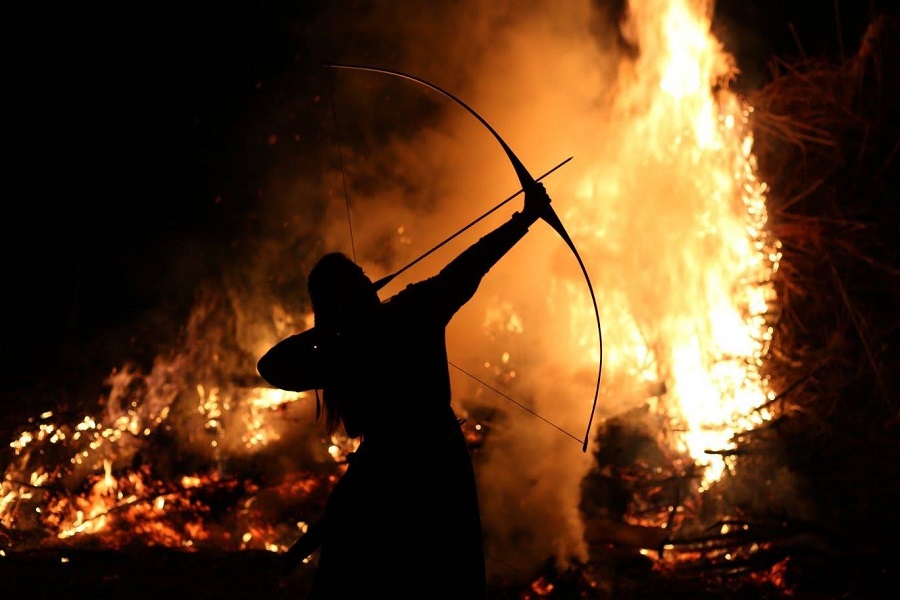
Why there is a battle in May in Varaždin?
The Knight Order of Saint Nikola Varaždin also has its tournament. The "Anđeoska strijela" tournament is traditionally held on the last weekend in May at the foot of the Old Town Castle in Varaždin. Each year, there is an increasing number of participants, a richer program and many visitors. In the morning, the associations arrive and set up their camps or camps. First, they make their way through the city, where all the associations, led by their flag, follow one another with the sounds of drums, flutes, songs. The tournament is officially opened by the mayor of the city, followed by an archery tournament where up to 50 competitors compete. Archers are shooting traditional wooden bows and wooden arrows at a distance of 20 meters. The archery tournament is followed by a solemn announcement of the winner, lunch, court dances, performances, demonstrations of military tactics, an archery workshop and even a brewery and production of local beer. At events like this, booth owners who sell their products are always present. So you can see blacksmiths, seamstresses, people who make jewelry and those who make little wooden swords and shields for the youngest. With the archery tournament, the most important thing is the Battle of the Granary of 1242. All associations take part in staging a historic battle relevant to the city of Varaždin. Before the battle, all members of the visiting associations who wish to participate in the battle come to the host camp to agree on a battle plan. Usually, the two warlords compete with each other, giving reasons why the other should relent and surrender. In this case, the knight of Varaždin Mihajlo defends the granary from the Tatars who burned and looted the surrounding villages. At the beginning of the battle, both warlords send three of their best knights to a duel of what is called God's judgment. Everyone agrees that the army whose knights defeat enemy knights, that she is the victor and that there is no need for the further battle and bloodshed of hundreds of people. The duels are always played between two knights from the same association as they have rehearsed choreography and no injuries can occur. But whoever wins the duel, the undefeated side is never satisfied and decides to attack the rivals. The battle is played out according to a plan that the audience, of course, does not know, so everything looks very attractive and interesting. What is always taken care of is the safety of the audience and participants. The audience has a place where they can see everything and make sure that nothing happens to them. Battles always end with great applause and exclamations, taking pictures and smiles. Still, staging a historic battle is not something every day and people are delighted to see authentically trained people fighting for their city. They are especially surprised to see women in battle, whether fighting with the sword or as an archer.
(Tournament “Anđeoska strijela”, 2017 in the video above)
How I got involved and what it’s like to be a woman dressed up like a man?
In my 2nd year of high school (Prva gimnazija Varaždin), there was a Medieval Week where we could learn about the Middle Ages in a different way than usual. I applied for a day when two knights came, actually members of the Knight Order of Saint Nicholas Varaždin. Honestly, I have never heard of them before, but this seemed interesting so, why not? These two were former Grand Master, Radivoj Miladinović and secretary of the association, Luka Borščak. They brought with them a lot of medieval weapons, such as swords, axes, shields, bows, and arrows. I had been interested in all of this since I was a kid. You know, when you grow up with one sister and two brothers, you enjoy making bows and arrows at home and enter the feeling of Lord of the Rings. So, I asked the Grand Master (his nickname is Pajo) if I could take the bow and pull the string. He was terrifically skeptical about that, but he let me. Once I pulled the string and did it pretty well, he looked at me pretty much speechless. "I have never seen someone do it so well, even some boys can't do it like that!" I think in that exact moment, my interest in archery was born.
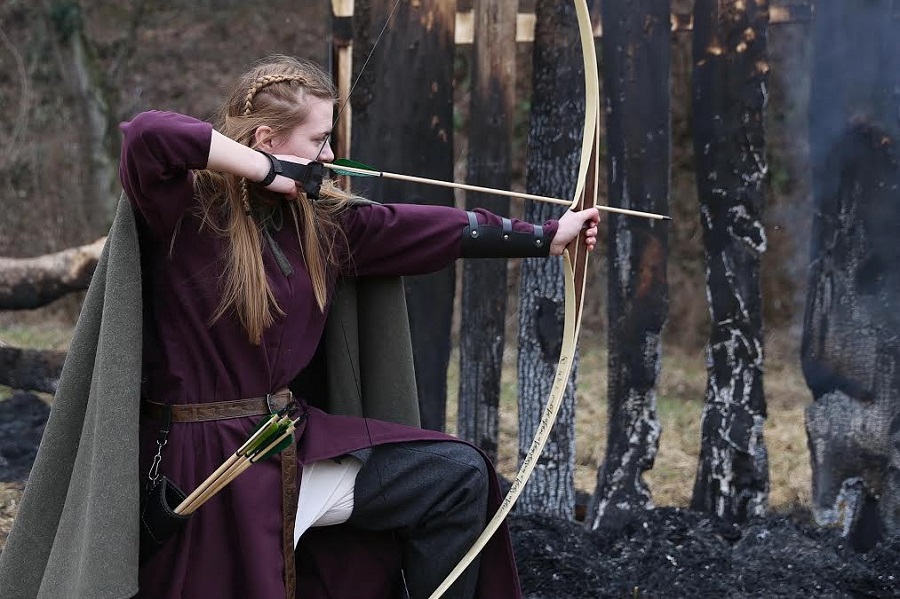
After that, I tried sword fighting with Pajo and enjoyed that throwback in history. He saw something in me and left me his business card. He told me: "Come to our meeting next Thursday and bring your parents with you. Since you're under 18, you'll need the permission of one of them." This was funny to me, like, he already saw me as a member of his Order. Well, I came next Thursday with my mother, it was the 5th of May, 2016. I didn't know what to expect, like, how many members there would be, the average age, who they even were. When we stepped into the yard, I was shocked. There were a couple of members and one of them was making a barbecue. A barbecue? Really? Like, okay people, I'm yours.
Joking aside, people were really nice to us, welcoming and friendly. Everything seemed to be awesome, till the moment I heard something about having to wear a dress. "But... Do I have to wear a dress? I'm not really into it... How will I move? Run? Fight in the battle?"
They looked at each other in confusion and finally said: "Okay, you can dress as a man, wear a tunic and hose."
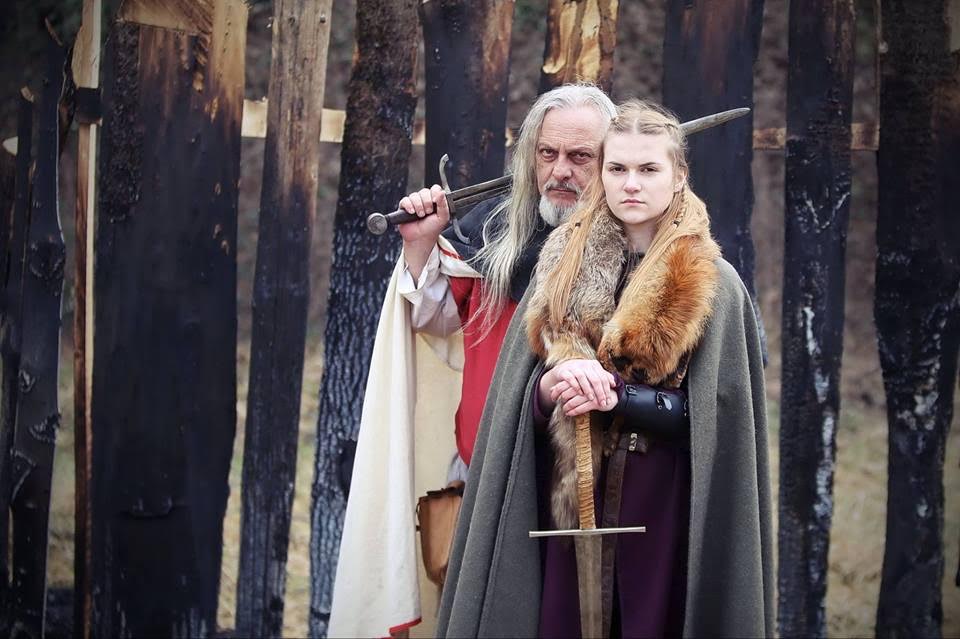
I believe I was the first woman to dress as a man in this Order. And I can tell you, sometimes I feel sorry for not wearing a light dress in those hot summer tournaments...
But nevermind, I got the status of the squire and through the next years, I was learning about the history of the Order, of Varaždin, etc. My role in the Order was an archer. They even bought me a bow and arrows! I enjoyed being in the battles and being part of the history group which nurtures chivalry, cavalierism, tradition, history, and friendship.
In addition to archery and swordsmanship, the Knights Order of St. Nicholas also performs staging, practices medieval military tactics, participates in various Medieval and renaissance festivals, organises workshops, etc. I met wonderful people, got chances that helped me in various ways, tried things I never have before and visited beautiful places. And believe me, it is not a cliché, I really enjoyed spending time in nature, sleeping under the stars and going into a night battle with fire on my arrowhead. Quite unique, isn’t it?
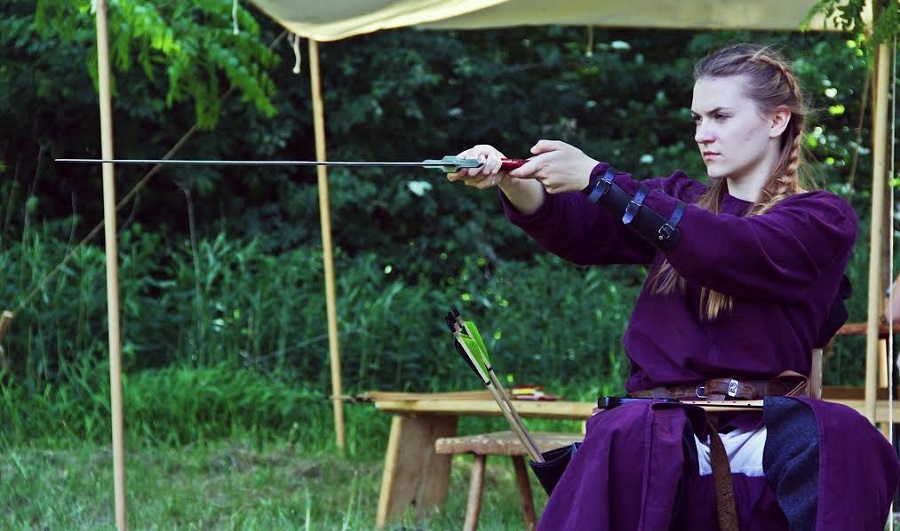
(The last photo is from Dimitrije Dimović.)
Croatian Cup Round of 16: Hajduk Falls to Gorica, Dinamo, Rijeka, Osijek Move to Quarters
October 31, 2019 - Dinamo and Rijeka routinely advanced to the quarterfinal of the Croatian Football Cup, while Gorica eliminated Hajduk in the most interesting match of the round of 16.
Gorica and Hajduk met in the biggest game of the round of 16 on Wednesday in Velika Gorica, which saw the home team top Hajduk 2:1 to reach the Cup quarterfinal for the first time in their history, while Hajduk has been eliminated from the round of 16 for the third time.
However, the last time Hajduk fell in the round of 16 was as the title defenders nine years ago to Istra, led by Zoran Vulic. They were also eliminated in the round of 16 in 1995 when they were shocked by Marsonia.
Gorica took the lead in the 64th minute from a 25-meter free-kick by Kristijan Lovric, and came one step closer to the victory in the 85th minute when Joey Suk scored from the counter to make it 2:1. A glimmer of hope for Hajduk was brought by Stanko Juric in the 88th minute for 2:1, though Hajduk was unable to score again.
There were no surprises in the match between Dinamo and Opatija, so much so that Dinamo secured the victory in the first half when all three goals of the match were scored.
The Croatian champion led with a goal by Damian Kadzior in the eighth minute. Mario Gavranovic's penalty in the 29th minute increased Dinamo’s lead to 2:0, while another goal by Gavranovic the 36th minute made it 3:0.
In the final round of 16 match, the title defenders Rijeka defeated Varazdin 2:1
Rijeka led 2:0 with goals from Petar Mamic in the 47th minute and Alexander Gorgon in the 54th minute, while Leonard Vuk scored in the 83rd minute to make it 2:1.
Lokomotiva had no problem against the third-seeded Vinogradar and won 3:0 for a spot in the quarters.
Slaven Belupo topped BSK Bijelo Brdo 2:0 to secure their spot in the next round, and Sibenik beat Belisce 2:1.
Osijek already advanced to the quarter last week after celebrating against Zadar 3:0.
Round of 16 results on Wednesday, October 30
Opatija - Dinamo 0:3
Gorica - Hajduk 2:1
BSK Bijelo Brdo - Slaven Belupo 0:2
Sibenik - Belisce 2:1
Vinogradar - Lokomotiva 0:3
Istra 1961 - Inter Zapresic 1:2
Varaždin - Rijeka 2:1
On Wednesday, October 23
Zadar - Osijek 0:3
Source: HRT
To read more about sport in Croatia, follow TCN’s dedicated page.
Varazdin County First in Croatia to Give Train Passengers Free Bicycle Transport
October 29, 2019 - Varazdin County moves to a more sustainable transport model by offering train passengers free bicycle transport.
HRTurizam writes that at the railway station in Varazdin, the chairwoman of the Varazdin County Tourist Board, Natalija Martincevic, and the director of the Varazdin County Tourist Board, Miran Bojanic Morandini, presented a unique project - free bicycle transport on trains.
“The County of Varazdin, in cooperation with HZ Passenger Transport, is the first in Croatia to launch the free bicycle transport project for train passengers. Citizens thus also acquire the right to free bicycle transport on trains operating in Varazdin County by purchasing a passenger ticket,” said Martincevic.
By combining bicycle and train transportation, tourists visiting Varazdin County, as well as locals, get even more travel options, resulting in a better and more meaningful offer. Better accessibility of the beauty of the County, as well as convenience in carrying out daily tasks, result in increasing the quality of life, stronger development of a new tourist offer, but also a more sustainable transport system.
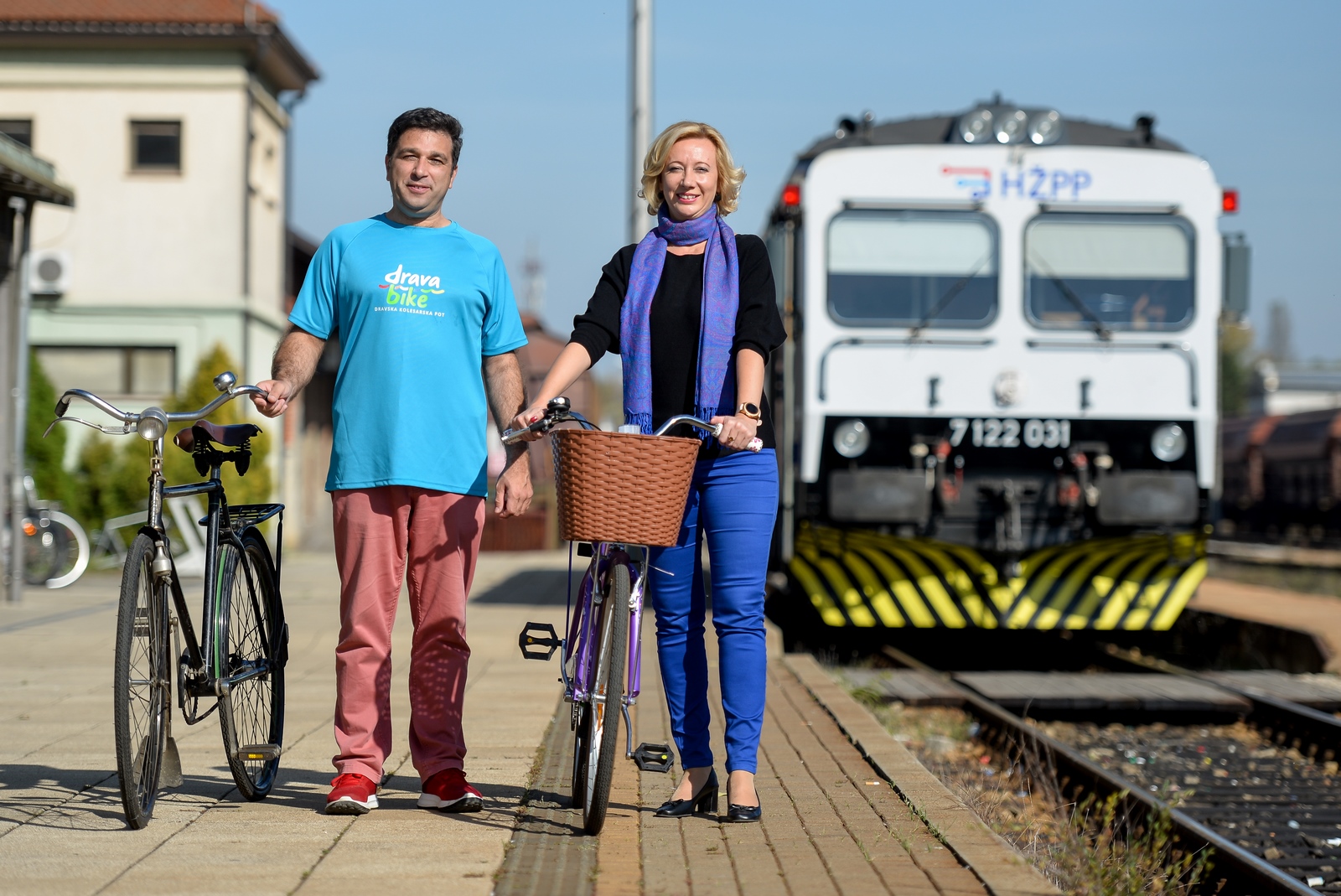
TZ Varazdin County
“Varazdin is currently the last point on one of the most beautiful and longest cycling routes from the source to the mouth of the Drava. More than 200,000 bicycles pass through this route and many of them use integrated transport, which allows for a much wider radius of travel. This is important news for both tourists and locals alike,” said Miran Bojanic Morandini, director of the Varazdin County Tourist Board.
This is just one of the many measures that Varazdin County is implementing in order to achieve traffic sustainability. Some of the other goals are to increase bicycle transport, as well as the share of rail passenger transport. This opens up new possibilities for sustainable travel for its citizens and tourists, which significantly contributes to the reduction of pollution, but also traffic safety.
“In the two years of our mandate, we have provided more than HRK 1,700,000.00 for the development of cycling tourism and cycling routes in Varazdin County. Varazdin County is one of the three Counties in Croatia to introduce the Cyclist Welcome Quality standard, and as many as 30 accommodations and catering facilities in Varazdin County have become part of it,” concluded Natalija Martincevic, chairwoman of the Varazdin County Tourist Board.
To read more about travel in Croatia, follow TCN’s dedicated page.
Varaždin Wins RegioStars Award as Part of CityWalk Project
ZAGREB, October 13, 2019 - The CityWalk international project, of which the northern Croatian city of Varaždin is part, which promotes walking in cities with a view to reducing pollution and improving people's health, received the RegioStars award in Brussels earlier this week.
This European award for innovative regional projects has been presented since 2004.
The goal is to improve air quality, reduce noise and make people healthier, said the European Commission, which organised the presentation of the award.
CityWalk received the award of the basis of votes by EU citizens, submitted online between July 9 and September 9.
Seventeen partner institutions from Croatia, Austria, Bulgaria, the Czech Republic, Hungary, Romania, Slovakia and Slovenia participate in CityWalk, which provides city dwellers with information on routes via a mobile phone app, encourages them to refrain from driving cars, and encompasses recommendations on encouraging mobility in cities and the expansion of pedestrian zones.
A total of €2.2 million was invested in the project, of which 1.9 million from the EU budget. The pilot project lasted from December 2016 to May 2019.
More Varaždin news can be found in the Lifestyle section.
MUP Varazdin: Celebrating Croatian Bureaucratic Excellence - Yes, Really!
October 10, 2019 - Croatia is not known for its efficient bureaucracy, but let's celebrate the exceptions, such as MUP Varazdin.
My record with Croatian bureaucracy is poor, and I dread all contact with officialdom here, for more often than not you are sentenced to an afternoon of being sent from room to room, waiting for hours and then being told you are missing a piece of paper and to try again tomorrow. For years, my wife took pity on my 'I am a useless foreigner who can't speak the language' look and heroically became a buffer zone between the bureaucrats and I, taking all of the pain away from me.
But there are some things that even she cannot help me with.
Like Brexit.
Being British and living in Croatia, I get asked about Brexit on a daily basis, and I am embarrassed to say that I have nothing smart to say on the subject, as it really does not affect me much. I have not lived in the UK for 20 years and do not plan to again, and I consider myself a citizen of the world rather than any particular nationality. If Brexit does indeed happen, a quick trip to Dublin will secure Irish EU passports for me and the kids via my Irish parent should there be a need. So Brexit doesn't really affect me in any way.
Apart from one.
The driving licence.
Swapping my UK licence for a Croatian one has been on my list of chores for years now, but with the reality of Brexit, it would appear that having a UK licence was going to be a pain. And so I braced myself for one more visit to Croatian bureaucracy. I was not encouraged by the experiences of one friend in Zagreb, who needed no less than five visits to MUP and endless hours of waiting before she finally got her driving licence a few months later.
But I had an advantage - I was dealing with MUP Varazdin. Although we like to complain about bureaucracy on occasion at TCN, one should also remember the positives. And MUP Varazdin deserve gold stars and chocolate biscuits for their efficiency, even if it has caused me some frustrations in the past.
As I previously wrote, after living in Dalmatia for thirteen years, it was quite a shock moving to Varazdin and finding that my daughters could not graduate from their year at school until Croatian bureaucracy had reduced their number of fathers from three to one - you can learn about why you should never have too many names in Croatia and the curious case of Paul David Raym here.
MUP Varazdin not only managed to establish the legitimacy of this father in the eyes of my daughters' school, but they even succeeded where those chaps in Dalmatia failed, by finding a little more space on my ID card when I moved. And so, after a decade of living officially as Paul David Raym Bradbury in Dalmatia, Paul David Raymond became my official name once more.
And so to my Brexit driving issue. With 3 weeks to go until Boris takes us out of the EU or prefers to be found lifeless in a ditch, the clock was ticking and I headed in to MUP Varazdin. I was braced for the wait, the language issue, the lack of comprehension of my UK licence and a host of questions, mentally resigned already to returning the next day with some piece of paper I needed to bring with me. But this was MUP Varazdin.
I was in and out of the building in 18 minutes, UK licence exchanged for a temporary one valid for 30 days, while I wait for my permanent one to arrive in 2 weeks. Total price 173 kuna.
And in just 18 minutes, my Brexit to-do list was completed, and my faith in Croatian bureaucracy at least partially restored after 13 years of Dalmatian marendas and 'come back sutra.'
It is not every day that things work in Croatia, but when they do, it is worth celebrating.
Varazdin, Medjimurje, Koprivnica-Krizevci Counties to Introduce Integrated Passenger Transport
October 2, 2019 - Medjimurje, Varazdin, and Koprivnica-Krizevci Counties will be the leaders of integrated passenger transport in Croatia.
HRTurizam reports that in cooperation with the Varazdin, Medjimurje and Koprivnica-Krizevci counties and Croatian Railroads (HZ), and as part of the "Integrated Passenger Transport (IPP)" project by the Railway Association, an agreement was signed at the beginning of the year for the "Integrated Passenger Transport Master Plan".
With this agreement, HZ Passenger Transport and the three northern counties begin active cooperation in the implementation of measures that will, in the long run, result in establishing integrated passenger transport throughout the three counties. This means that in a few years, we will have a public transport system where the passenger will be able to easily combine train and bus lines with a single transport ticket and arrive at almost any location in the three counties throughout the day.
It is important to note that Integrated Passenger Transport is applied by all developed regions of Europe and the world. Experts are unique in assessing that such a system provides quality access to the entire urban, suburban and rural areas in a region, and it significantly improves the quality of life and competitiveness of the economy, since workers can easily and conveniently reach their jobs and meet many other needs without using a car. This means that there is less traffic congestion, that no parking is required, the environment is less polluted and the transport system as a whole is safer.
"For the past five years, we have seen a 10 percent drop in public transport, while the European Union has grown steadily. A small number of lines, inefficient systems, and obsolete rolling stock are a major problem for the rail and bus systems, and a transformation of the entire system is needed that will only come to life if we start thinking about traffic and the way these three counties think. We are entering a period where more than ever will be invested in railway infrastructure and the development of railway transport, and I am glad that it is precisely Medjimurje, Varazdin and Koprivnica-Krizevci County that will be the first and the leaders of integrated transport in Croatia for the benefit of our citizens and economy,” stated Nikolina Brnjac, State Secretary for Transport at the Ministry of the Sea, Transport and Infrastructure.
"In the area of Medjimurje County, we carry about 2 million passengers a year, and because of these passengers it is important to improve the functionality of transport and contribute to their mobility," concluded the President of the Board of HZ Passenger Transport, Zeljko Ukic.
The total value of the project is 5.2 million kuna - each of the counties has set aside around 260,000 kuna, and EU funds cover the rest. The project also plans to build and modernize a new high-efficiency line between Cakovec-Varazdin-Lepoglava-Zabok, and a feasibility study is underway, with plans to complete the works by September 2020, said Varazdin County prefect Radimir Cacic.
Also, a study on a new network of bus lines for these three counties is being prepared, and the plan is to establish a so-called "pilot line" consisting of trains and buses and introduce a single map for both modes of transport. The pilot line, for which only one ticket will be sufficient, should cross the route Varazdin - Lepoglava - Bednja - Trakoscan, with a changeover in Lepoglava, and Varazdin - Ludbreg - Mali Bukovec, with a changeover in Ludbreg.
"In three counties, the train and bus routes will be harmonized, there will be about 20 departures in the main routes from morning to late at night, all of which can be used by purchasing a single transport ticket," said Cacic.
To read more about travel in Croatia, follow TCN's dedicated page.
Varaždin Piano Teacher Becomes First Foreign Woman to Conduct Choir in Iran
September 25, 2019 - Varaždin has a rich musical tradition, and it also produces some rather unusual firsts on occasion, such as piano teacher Janja Knapić's recent trip to Iran.
A lovely little story from a recent meeting I had in Varaždin, retold by the person who told me about it.
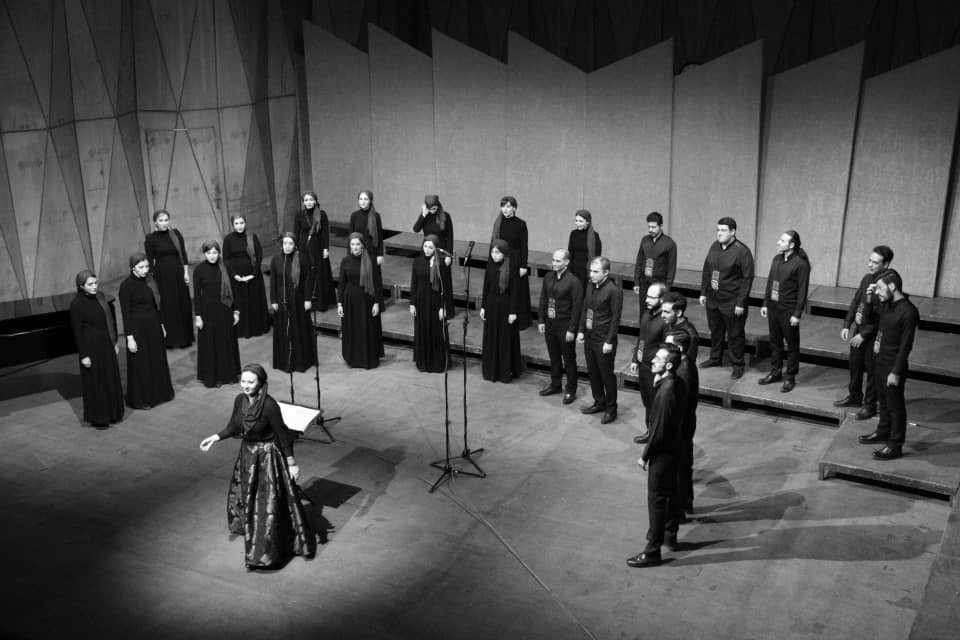
Janja Knapić, a piano teacher at The Varaždin School of Music wrote a part of cultural history of Iran this July. It’s a bit unusual for this distant and mysterious country to have women conduct their choirs, let alone a foreign woman.
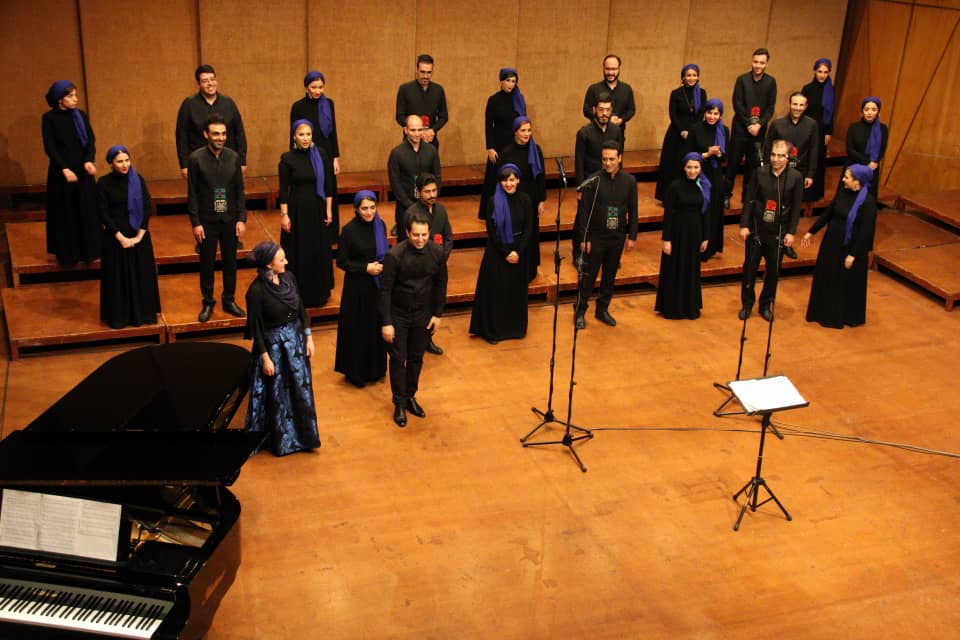
This versatile musician coached members of the mixed Tonal choir from Tehran to perform Croatian compositions that the audience enjoyed at a concert that took place on July 18th and 19th in Roudaki Hall, Tehran. It has undoubtedly been a challenge for Janja, who otherwise conducts multiple vocal groups in her homeland.
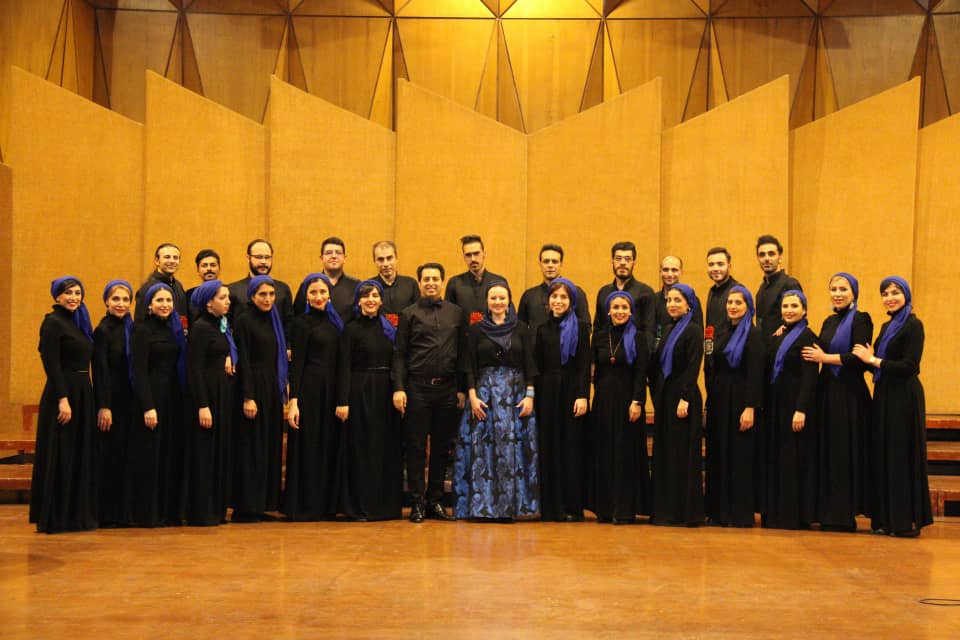
She leads the Academic choir of FOI University, Varaždin whose members she claims to be exceptionally proud of, since they are progressing nicely. There’s also her unique project called “Vocal Popular Music Ensemble of the Varaždin School of Music”, that she was even able to turn into a school subject. The ensemble gets quite admirable results as well.
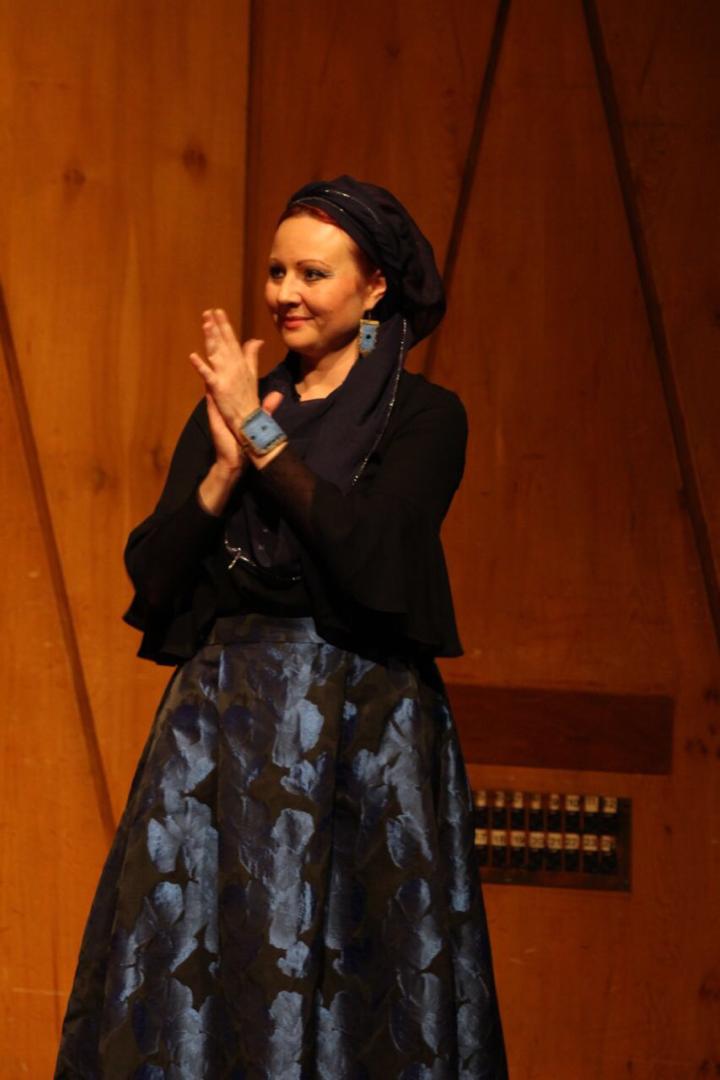
To date, she contributed to two international “Ars choralis” courseology symposia in Zagreb, organized by the Croatian Choral Directors Association, where she was able to meet many colleague lecturers. It was right there that she met Iranian maestro – Milad Omranloo, with whom she realized a collaboration this year. Omranloo liked the way she worked with choirs, and since his Tonal choir needed professional assistance, they mutually agreed on holding a concert in Iran.
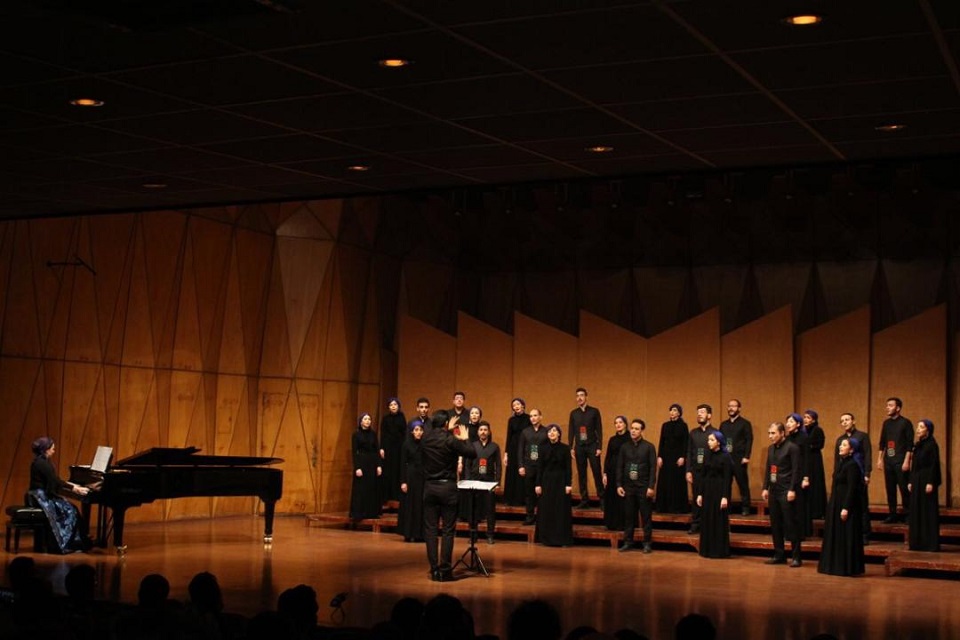
Knapić had this idea that it would be interesting if the Iranian audience was presented with Croatian music and its’ composers, so a part of her program was based on that idea. Her tasks in Tehran were first and foremost rehearsals with Tonal Choir, and she had that privilege to conduct half of the concert’s repertoire. She recorded pronunciation of the words that she shared with the choir members, and they quickly got the hang of them.
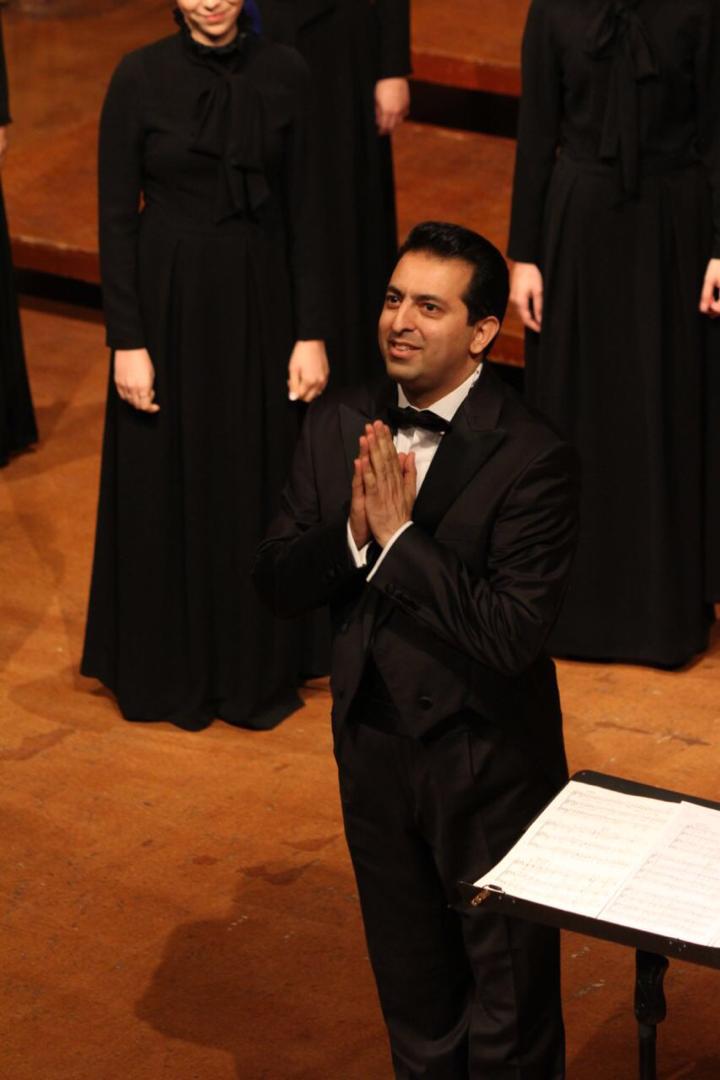
Apart from the choir rehearsals, at the host’s request she held some master classes as a vocal coach.After the group vocal master class, there was a lot of interest for individual singing and piano playing master class. In the end, it came to even 18 individual class attendees.Upon her arrival to Iran, she was also invited by the Croatian Embassy in the Islamic Republic of Iran. It was followed by a meeting at the Embassy, whose personnel dearly accepted the invitation to concert.
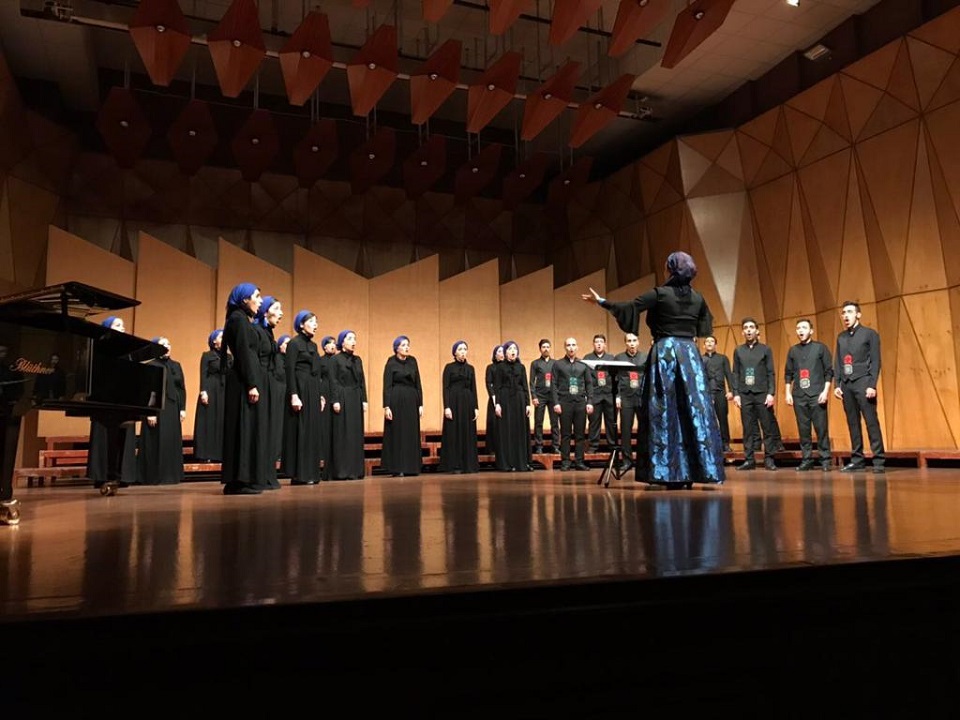
Among other compositions, there are two worth mentioning: “Letovanić” and “Moja diridika” that utilize unique folklore way of singing, otherwise unused in Iranian choir singing.
49th Varaždin Baroque Evenings Festival Begins
ZAGREB, September 21, 2019 - The Gothenburg Baroque Choir and Orchestra and Croatia's Chorus Dominicalis cathedral choir opened the 49th Varaždin Baroque Evenings festival on Friday, with Sweden as the partner country.
The choir performed works by Vivaldi and Handel under the baton of Magnus Kjjelson.
Until October 1, the event, held under the auspices of President Kolinda Grabar-Kitarović, will feature another 27 concerts in Varaždin, several other locations in Croatia and in Ptuj, Slovenia.
This is the first time the partner country is Scandinavian.
"Swedes love music, Sweden has the largest number of choirs in the world per capita, and since the group ABBA, we have been the third largest exporter of music in the world," Ambassador Diana Helen Madunić said at the opening ceremony.
The festival includes performances by several Swedish musicians such as the Renaissance ensemble Romeo & Julia Kören, the Hazelius Hedin folk duo, organist Hans Fagius, Ensemble Villancico and the Royal Swedish Chamber Orchestra, the Oslo Circles baroque ensemble from Norway as well as Croatia's Project Lazarus, Responsorium, Antiphonus and the Croatian Baroque Ensemble.
The festival also brings accompanying events under the title Total Baroque which include an international flower show, a photo and sculpture exhibition by Stephan Lupino, and a gastronomy offer including baroque beer and wine.
More news about festivals in Croatia can be found in the Lifestyle section.
Medena Rakija, Bee Crisis, Natural Goodness: Magical OPG Franic near Varazdin
September 8, 2019 - We are delighted to welcome Elizabeth Wilson to TCN, especially with a great first article on one of the treasures of continental Croatia, the honey goodness of OPG Franic. Welcome, Number 139! If you would like to write about the Croatia, Montenegro or Slovenia where you are, please contact us on This email address is being protected from spambots. You need JavaScript enabled to view it.
What is the future of Croatia? That question can attract infinite speculation, but according to Mirko Franić, a Croatian beekeeper with almost four decades of experience, it can’t be answered without looking first to the bees. “What happens to the bees will happen to us."
His business, OPG Franić, has provided a living for his family since the late 80s. He is a registered instructor of apiculture, and a strong proponent of Croatian tradition and sustainable agriculture. Born and raised in Daruvar, and a longtime resident of Varaždin, this Slavonian is a familiar face for many people throughout Croatia. For decades now, he has sold his honey products at fairs, festivals and at tourist destinations throughout the country.
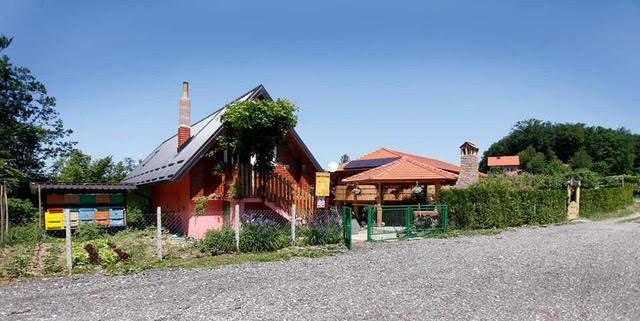
(The house that bees built: OPG Franić started in a small shack near their present location in Cerje Tužno, but with hard work and attention to the market for honey products, they have expanded their bee farm to include a local retreat and a tourist destination for people interested in the world of bees.)
“This has been a catastrophic year for bees, unlike any I have ever seen,” he warns. “Not just in Croatia, but worldwide.” Increasingly unpredictable and unstable weather wreaks havoc on the cycles of seasonal blooms that bees depend on. The health of the bees is in turn absolutely essential for the food supply we rely on. The increasing use of pesticides and herbicides encroach even in isolated farms. “If local bees can’t thrive,” Mr. Franić says, “neither can local agriculture.”
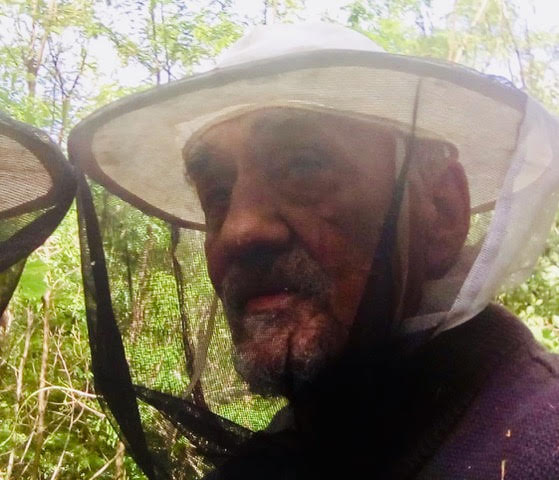
A similar disrupted cycle occurs in the marketplace: it’s difficult to sustain the scale of production necessary to make a living from honey, yet the market doesn’t favor small-scale local family farms. Unfair advantages of international trade add further obstacles to succeeding as a beekeeper. “Local honey is always the best option for consumers, and of course it’s important to support our local ecosystem, yet the European Union is a net importer of honey. We can buy all the honey from China we want, but without bees, without our bees, we’ll go hungry. This year,” he adds, “I worry that the bees won’t have enough even for themselves. We have to support them.”
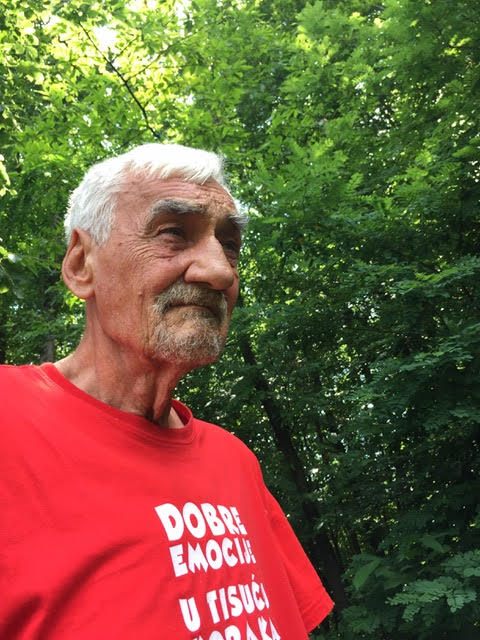
(“In forty years of beekeeping, I’ve never seen such a difficult season for bees,” warns Mirko Franić. The weather is ever more unstable and unpredictable. Why does that matter? “The future of bees will be the future of all of us.”)
But even though bees are recognized for the essential role they play in the circle of life, and although their products (including honey, propolis, royal jelly) provide both food and medicine for people, the situation gets worse every year. Many people push back against this trend: there’s an increasing interest in sustainable agriculture and promoting harmonious relationships with the natural world. Varaždin County, for example, features a variety of ecotourist destinations to visitors, and the Franić family farm is one along the route.
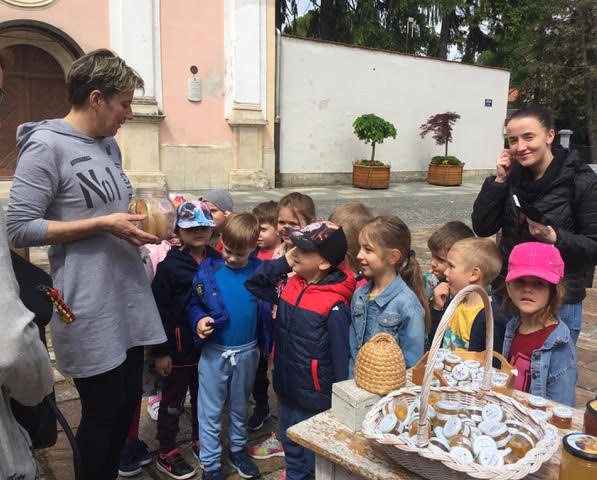
(Passing on knowledge of bees and awareness of their important role is an important part of the values of OPG Franić. Snježana Franić, from her year-round stand in Varaždin, shows schoolchildren an example of honeycomb, so they can see how bees build their homes and where they store their honey.)
“People eventually will return to many of the traditional ways of life, they won’t have a choice.” Mr. Franić predicts. “In the meantime, it’s important to protect the sources of our sustenance and to increase people’s awareness of the natural world. It is our responsibility to pass traditional knowledge to future generations.”
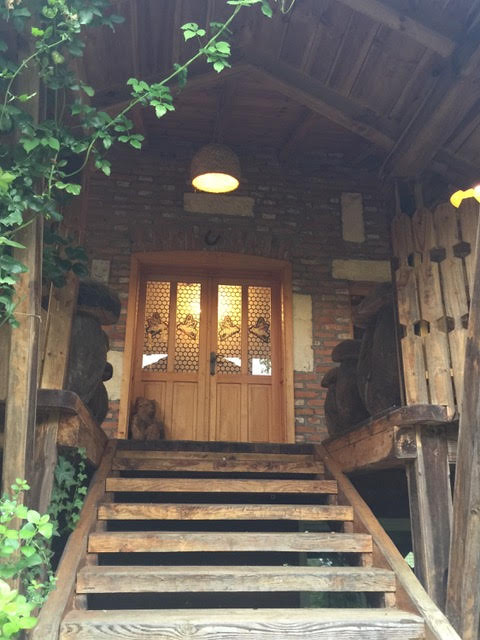
(Through these doors visitors can enter into the life of beekeeping and sample their products.)
With a bit of entrepreneurial ingenuity, Mirko Franić has found a unique way forward, entwining another Croatian tradition with the tradition of the family farm: he makes rakija from his honey. Šlivovica, of course, which is poorly translated into plum brandy, is one of the most basic rituals of Croatian culture, and one of the first traditions that visitors discover in Croatia. People then hear about medica, which is šlivovica with honey added.
“There’s a big difference between medica and medena rakija,” Mirko is careful to point out. “Rakija is usually made with plums or other fruit. It has a strong, sharp taste.”
Medena rakija, on the other hand, is a liquor made straight from honey, and only from honey. It retains the beautiful gold color and sweet smooth taste. The alcohol content ranges between 20 and 30%, depending on the batch, and consistently exceeds all standards for quality. Mr. Franić owns the copyright for his recipe, and Medena Rakija is the brand name of the leading product of O.P.G. Franić. It therefore has the special status of being both a unique and original product, and at the same time a part of a long and proud tradition of Croatian spirits.
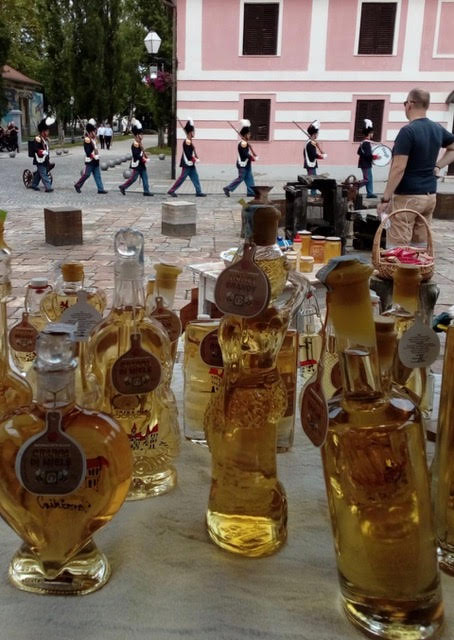
(The Franić stand on the Trg Tradicialna Obrta, in the Old Town, is just one of many Varaždin tourist offerings, selling its locally produced honey products in the shadow of the Ursuline convent.)
As of 2008, the family expanded the farm to include a beautiful retreat in the small village of Cerje Tužno, 14k outside of Varaždin, near the border with Slovenia. There he keeps his hives, extracts the honey, and makes the rakija. The grounds are groomed so that there is always something in bloom to interest the bees. There is also a lovely chalet designed to welcome both locals and newcomers to Croatia, able to accommodate tour buses or to rent for private parties and special events.
His greatest pride is in knowing he has offered consistent excellence while honoring a sense of responsibility to the natural world. “I will never compromise on the quality,” says Mr. Franić, “and my customers know that.” As proof, he passes his hand over an impressive display of medals, plaques and prizes. Through the years, the business he created has gathered more than 300 awards for the quality of his honey, honey brandy and honey products, including another novelty for many people: honey vinegar.
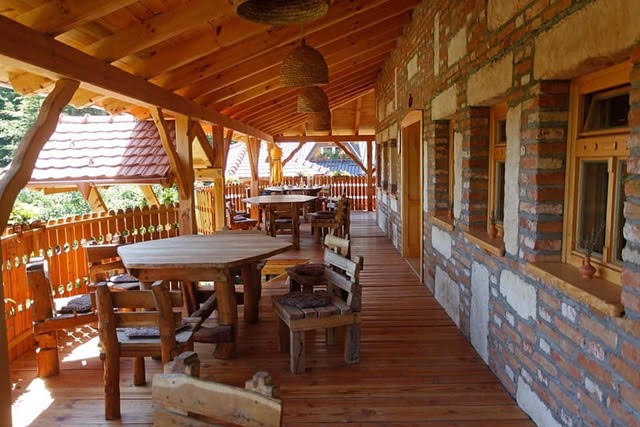
(Groups of up to 80 people are welcome to visit the bee farm and sample the honey products, and to enjoy peace, quiet, and some good company at the outdoor terrace and barbecue.)
He first started the business with his late wife, Slavica, and it is now managed by his daughter, Snježana, who is a familiar sight at their permanent stand on the Trg Tradicialna Obrta in Varaždin. Their rakija is sold in a diverse assortment of bottles and when the sun shines on the booth, or at dusk when she switches the overhead light on, they glow with a golden light. She paints the bottles by hand with street scenes of Varaždin and other images. School children who pass through the square on class outings buy miniature jars of honey, which she personalizes for them with a practiced hand. She has honeycomb always within reach which she is happy to show them, providing a mini-lesson on one of the most fascinating processes in the natural world. Travelers buy these honey products as charming souvenirs of Croatian-made products. And so OPG Franić interweaves yet another essential Croatian tradition: tourism.
Snježana shares her father’s absolute confidence in the quality of their products. “We always offer a taste of rakija to people who visit our booth,” she says as she draws a sample from the thermos behind the counter. “All they have to do is try it. When people taste it, they want it. They realize immediately it is something special.” They have a solid base of return customers throughout Croatia, and many from abroad who have been known to travel far out of their way just to replenish their supply of Medena Rakija.
Although Mr. Franić has found a way to make the most of his honey and create a solid business, the future, he emphasizes, is not secure. “It’s not a question of where people will buy their honey for tea, or propolis for mosquito bites. What happens to the bees will happen to us. The balance of nature is at stake. This is a question of survival.”
You can learn more about OPG Franic and watch their promo video on the official website.
European Team Championships: Croatia Finishes 5th in Varaždin
August 12, 2019 - The Croatia athletics team finished fifth in the Second League of the European Team Championships held this weekend in Varaždin.
After 40 disciplines, Croatian athletes scored 306 points, as did Latvia in fourth, though the Latvian team earned more first places, reports HRT.
Estonia finished in the first place and will be promoted to the First League after winning 336.5 points, while Slovenia came in second with 321 points and Denmark in third with 313 points.
Israel (8th), Cyprus (9th), Luxembourg (10th), Georgia (11th), and Malta (12th) dropped out of the Second League, while Serbia has been promoted to the Second League.
On Sunday, Croatia secured victories by Olympian gold medal javelin thrower Sara Kolak, and Dino Bošnjak who finished on top in the 3000-meter race. Kolak and Bošnjak join Sandra Perković, who was best discus thrower on Saturday.
Kolak justified her role as the favorite, although her score in Varaždin was still not her highest. However, a throw of 57.97 meters in the second series was enough for Kolak to compete.
And while Kolak's victory was expected, Bošnjak very pleasantly surprised in the 3000-meter race. The Croatian representative led the run from the very beginning and in an excellent finish, he was more successful than the Danish representative who could only follow his rhythm. Bošnjak had time at the finish to celebrate his victory and slowed down significantly, so his winning result was 8:01.29 minutes in the end, though it could have been well under eight minutes.
On Sunday, the second place was won by Ivan Lončarek in the 100-meter hurdles, Marija Tolj in the shot-put, Ana Šimić in the high jump and Matea Parlov in the 5000-meters. Lončarek ran 13.53 seconds, Šimić jumped 1.94 meters, while Tolj threw 15.73 meters and Parlov, with a time of 16: 03.71 minutes, set a personal record.
A significant number of points for Croatia were secured by Sven Cepuš in the 800-meters with a time of 1:49.60 minutes, and the women's 4x400 meter relay which finished in 3:40.82.
Fourth place was secured by Ivan Horvat in the pole vault (5.20 meters), Filip Mihaljević in the discus throw (62.30 meters) and Filip Svalina in the 3000-meters with hurdles (9:01.45). Filip Mičuda came in fifth of the hammer throw (62.42 meters), while the men's 4x400 meter relay took the same position with a time of 3:10.31. Bojana Bjeljac came in sixth of the 1500- meters (4:21.88), while Nikola Anđelić in the 110 meters with hurdles (14.74), and Sanjin Šimić in the triple jump (15.43 meters), took seventh place.
The only three Croatian representatives to finish at the bottom of the standings on Sunday were the 17-year-old Veronika Drljačić in the 200-meters (24.69) and Zvonimir Ivasković in the 200-meters (21.92), who both finished 10th. Marija Ivanković in the long jump (5.31meters) placed 11th in her respective discipline.
To read more about sport in Croatia, follow TCN’s dedicated page.


